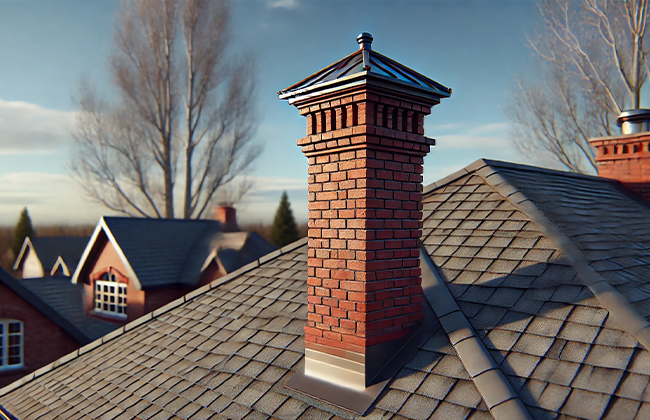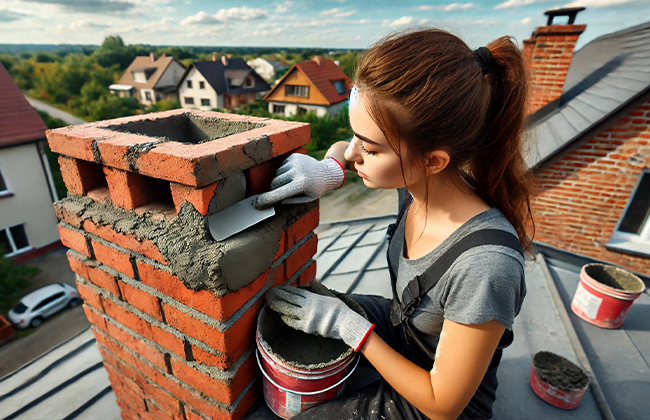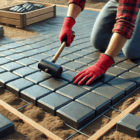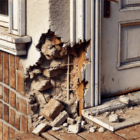Chimney tuckpointing is a crucial process for maintaining the mortar joints in your chimney structure, ensuring it remains water-tight and structurally sound. Regular tuckpointing helps prevent the deterioration that can lead to expensive repairs, while also enhancing your home’s energy efficiency and aesthetic appeal. Whether it’s addressing visible cracks or eroded mortar, timely maintenance is key to prolonging your chimney’s lifespan.
Table of Contents
What is Chimney Tuckpointing?
Chimney tuckpointing is the process of repairing and refreshing the mortar joints between the bricks of a chimney. This essential maintenance helps to prevent moisture from seeping into the chimney, which can lead to structural damage and deterioration over time. By carefully removing the old, eroded mortar and replacing it with new, durable mortar, tuckpointing restores the chimney’s integrity and appearance.
This technique not only prevents water damage but also extends the life of the chimney, ensuring it remains functional and safe for use. Proper tuckpointing requires matching the new mortar to the existing one in color and texture, maintaining the aesthetic look of your chimney while fortifying its structure. Now, let’s explore how to assess when your chimney actually needs this crucial maintenance.
Assessing the Need for Tuckpointing
Knowing when to undertake tuckpointing is key to maintaining the longevity and safety of your chimney. Let’s talk about how you can assess the need for this important maintenance.
Visual Inspection
Start with a simple visual inspection of your chimney. Look closely at the mortar between the bricks. Are there any cracks, crumbling spots, or sections where the mortar seems to be missing entirely?
These are clear indicators that the mortar has worn out and needs attention. Such damage might seem minor, but it can escalate quickly if water infiltrates these gaps, leading to more severe issues like structural damage.
Physical Test
After your visual check, it’s a good idea to perform a physical test to further evaluate the mortar’s condition. You can do this using a basic tool like a screwdriver. Gently prod the mortar joints with the screwdriver; if the mortar is soft and crumbles easily, this is a sign that it has lost its integrity and needs to be replaced. Healthy mortar should be firm and difficult to dislodge, indicating it still provides strong support and protection.
Both these steps are straightforward but essential in determining whether your chimney requires tuckpointing. Regular checks like these help catch potential problems early, preventing costly repairs and extending the life of your chimney.
Stay tuned, because in the next section, you’ll read about the various benefits of chimney tuckpointing.
Benefits of Chimney Tuckpointing
Tuckpointing your chimney isn’t just about fixing up what’s broken; it’s about securing the future of your home. Let’s break down the significant benefits that make this maintenance work crucial.
Structural Integrity
One of the most vital roles of tuckpointing is enhancing and maintaining your chimney’s structural integrity. Over time, mortar can deteriorate due to exposure to the elements, which if ignored, leads to the weakening of the chimney’s structure. Regular tuckpointing reinforces the strength of the mortar joints, ensuring the chimney remains stable and upright. This not only prevents leaning or collapse but also ensures that it can withstand harsh weather conditions.
Moisture Control
Water can be a home’s worst enemy, and a chimney with compromised mortar joints is an easy target for water ingress. By sealing the gaps in the mortar, tuckpointing acts as a barrier against moisture penetration. This is crucial in preventing the myriad of problems that moisture can cause, such as mold, mildew, and even damage to nearby wooden structures due to rot. Keeping your chimney dry on the inside helps maintain a safe and healthy environment in your home.
Aesthetic Value
Let’s not overlook the visual improvements tuckpointing can offer. A chimney with fresh, clean mortar lines greatly enhances the overall appearance of your home’s exterior. Whether you’re thinking about selling your home or just pride yourself on its upkeep, tuckpointing can significantly boost curb appeal, reflecting a well-maintained property.
Longevity
Routine tuckpointing extends your chimney’s lifespan. By addressing minor issues before they escalate into major ones, you save on potentially huge repair costs down the line. It’s much like taking care of any valuable investment; regular upkeep prevents the need for expensive overhauls and ensures your chimney can serve its purpose for decades.
Each of these benefits contributes to not just a safer, more attractive home but also peace of mind knowing that your chimney is in top condition. And knowing these benefits, you might now be wondering about the signs that indicate your chimney needs tuckpointing. In the upcoming section, we’ll explore the key indicators to help you determine when it’s time to call in the professionals.
Signs When You Need Chimney Tuckpointing
It’s essential to know when your chimney requires tuckpointing to prevent small issues from becoming major headaches. Here are some clear signs that your chimney might need some attention:
1. Eroded Mortar
If you notice that the mortar between the bricks of your chimney is receding or flaking away, it’s a clear sign that erosion has set in. This typically happens due to exposure to the elements over time and is a natural part of the aging process for chimneys. However, once you spot this erosion, it’s crucial to address it promptly to maintain the structural integrity of the chimney.
2. Visible Cracks
Cracks in the mortar or the bricks themselves can appear small at first but can quickly become serious. These cracks not only weaken the structural stability of your chimney but also create pathways for water to enter, which can lead to more significant damage internally and externally. Spotting and sealing these cracks early can save you a lot of trouble and expense later on.
3. Loose Bricks or Stones
When the mortar fails, bricks or stones can become loose. This not only poses a risk to the chimney’s structure but can also be dangerous if bricks start to fall out. Loose bricks need immediate attention to prevent further deterioration and potential safety hazards.
4. Water Damage
If you see signs of moisture in your attic, on your ceilings near the chimney base, or even efflorescence (a white, powdery substance) on the chimney itself, it’s a strong indicator that water is penetrating the chimney. This moisture can lead to mold and mildew growth, as well as further damage to the chimney and surrounding materials.
Recognizing these signs early and responding to them can significantly extend the life of your chimney and reduce the likelihood of costly repairs. As you keep an eye out for these indicators, it’s also good to consider the potential costs associated with tuckpointing, which we will explore in the next section on Chimney Tuckpointing Cost.
Chimney Tuckpointing Cost
Grasping the costs associated with chimney tuckpointing can help you budget effectively and make informed decisions about maintaining your home. The cost for tuckpointing a chimney can vary based on several factors, including the extent of damage, the height and accessibility of the chimney, and regional labor rates.
Factors Influencing Cost
- Extent of Damage: More extensive damage requires more materials and labor, increasing costs.
- Chimney Size and Accessibility: Larger chimneys or those that are difficult to access may require special equipment or additional labor, which can drive up the price.
- Material Costs: The type of mortar used can affect the cost, as some materials may be more expensive due to durability or matching requirements.
- Regional Labor Rates: Costs can vary significantly depending on where you live. Urban areas tend to have higher rates than rural areas.
Typical Cost Range
Here’s a general breakdown of what homeowners might expect to pay for chimney tuckpointing:
| Extent of Damage | Cost Range |
| Minor | $500 – $1,000 |
| Moderate | $1,000 – $1,500 |
| Extensive | $1,500 – $2,000 |
These costs are indicative and can vary based on the specific conditions of your chimney and the pricing standards of the professionals in your area.
Getting a Quote
It’s advisable to get multiple quotes from local professionals to ensure you are getting a fair price. Most companies will offer a free inspection and quote, providing you a detailed breakdown of costs and the work needed.
Investing in chimney tuckpointing not only enhances the safety and appearance of your home but also protects against more significant expenditures down the line due to neglected chimney maintenance. After grasping the costs involved and preparing for this essential maintenance, you might consider whether you want to hire a professional or attempt DIY tuckpointing, which we will explore in the next section.
DIY Chimney Tuckpointing
If you’re handy and have some basic masonry skills, taking on DIY chimney tuckpointing can be a rewarding and cost-effective way to maintain your chimney. It’s not just about saving money; it’s also about taking hands-on care of your home. Here’s how you can tackle this task:
Tools Needed
To get started, you’ll need a few essential tools:
- Chisel and Hammer: For removing the old, damaged mortar.
- Mortar Mix: Select a mix that matches your chimney’s existing mortar in color and composition.
- Trowel: For applying the new mortar neatly between the bricks.
- Safety Gear: Don’t forget protective glasses and gloves to keep you safe from debris.
Steps to DIY Tuckpointing
- Preparation: Begin by setting up a stable working area. Make sure you have secure footing, especially if you need to work at height.
- Removing Old Mortar: Use your chisel and hammer to carefully remove the deteriorated mortar. Be gentle to avoid damaging the bricks.
- Mixing the Mortar: Follow the instructions on your mortar mix to prepare it. Achieving the right consistency is key—it should be firm enough to hold its shape, but pliable enough to press into the joints.
- Applying New Mortar: Use your trowel to apply the mortar. Fill the joints completely and smooth them out to ensure a watertight seal and a neat finish.
- Curing: Allow the mortar to cure as recommended. This usually takes several days, during which you should protect the area from any rain or extreme temperatures.
Tips for Success
- Match the Mortar: Getting a close match to your existing mortar in terms of color and texture is crucial for both aesthetic and structural reasons.
- Take Your Time: Rushing this job can lead to subpar results. Careful removal and precise application are crucial for a durable repair.
DIY chimney tuckpointing can significantly extend the life of your chimney, improve its function, and enhance the look of your home’s exterior. However, if the damage is extensive or the chimney is particularly high or difficult to access, you might consider hiring professionals. This leads us into our next section, where we’ll explore what goes into professional chimney tuckpointing repairs and when it might be the better option.
Professional Chimney Tuckpointing Repair

When it comes to chimney tuckpointing, sometimes the job is best left to the professionals, especially if the work is extensive or the chimney is particularly difficult to access. Hiring a professional can offer peace of mind knowing that the job will be done safely and correctly with the right tools and expertise.
Why Choose Professional Tuckpointing?
- Expertise and Experience: Professionals bring years of experience and specialized training, which is crucial for tackling complex or high-risk tuckpointing jobs.
- Advanced Tools: Professional chimney repair teams are equipped with the necessary tools and machinery to safely reach and repair high or awkwardly positioned chimneys.
- Quality Assurance: With a professional service, you often receive guarantees on the workmanship and materials used, ensuring that the repair lasts and provides value for your investment.
- Safety: Working on chimneys, especially those that are tall or in poor condition, can be hazardous. Professionals are trained to manage these risks effectively.
What to Expect with Professional Tuckpointing
- Inspection and Assessment: The first step is a thorough inspection of your chimney to assess the extent of damage and plan the best approach for repairs.
- Quote and Contract: After assessment, you will receive a detailed quote and timeline for the work. This helps manage expectations and ensures transparency.
- Preparation and Setup: Before the actual tuckpointing begins, professionals will set up the necessary scaffolding and safety measures.
- The Tuckpointing Process: Using tools like grinders and tuckpointing trowels, professionals will carefully remove the old mortar and apply new mortar, ensuring each joint is perfectly filled.
- Cleaning and Final Inspection: After the repair, the site is cleaned up, and a final inspection ensures that the work meets all the agreed-upon standards.
Professional tuckpointing can be more expensive than a DIY approach, but the additional cost brings expertise, equipment, and safety measures that are worth the investment for complex projects.
As you consider the benefits of hiring professionals for your chimney repair needs, it’s also important to understand the potential costs involved. In the next section, we’ll discuss the typical price range for chimney tuckpointing services and factors that influence these costs.
Price for Chimney Tuckpointing
When planning for chimney tuckpointing, it’s crucial to understand the costs involved, as they can vary significantly depending on a few key factors. Getting a handle on these can help you budget more effectively and choose the right contractor for the job.
Factors Affecting Price
- Chimney Condition: The more extensive the damage, the more work required, which can increase the cost.
- Chimney Size and Location: Larger chimneys or those in hard-to-reach places typically cost more to tuckpoint due to the increased labor and equipment needed.
- Local Market Rates: Prices can differ based on where you live and the prevailing market rates for professional masonry work.
Typical Pricing Structure
To give you a clearer idea of what you might expect to pay, here’s a breakdown based on the severity of the chimney’s condition:
| Chimney Condition | Estimated Cost Range |
| Minor Damage | $500 – $1,000 |
| Moderate Damage | $1,000 – $1,500 |
| Extensive Damage | $1,500 – $2,000 |
These figures are estimates and can vary. For the most accurate pricing, it’s advisable to get quotes from multiple contractors.
Getting the Best Price
- Multiple Quotes: Always obtain several estimates to compare prices and service offerings.
- Check References: Look at past work and speak to former clients to ensure you’re hiring a reputable service provider.
- Understand the Scope: Make sure you and the contractor are clear about the work to be done, which can prevent unexpected costs.
Investing in chimney tuckpointing not only addresses immediate repair needs but also contributes to the longevity and efficiency of your chimney, leading to cost savings over time. Understanding the upfront costs can prepare you for this valuable home maintenance investment, which seamlessly leads us into considering the long-term cost savings of proper chimney tuckpointing in our next section.
Long-Term Cost Savings through Proper Chimney Tuckpointing
Investing in regular chimney tuckpointing might seem like just another expense, but it can actually lead to substantial long-term cost savings. Here’s how maintaining your chimney properly can pay off:
Avoids Expensive Repairs
When you keep up with chimney tuckpointing, you’re essentially preventing minor issues from ballooning into major problems. For instance, small cracks and gaps in the mortar, if left unrepaired, can allow water to enter and cause significant damage not just to the chimney but potentially to the structure of your home. Addressing these issues early on with tuckpointing can save you from facing hefty repair bills in the future.
Improves Energy Efficiency
A chimney in good condition contributes to better heating efficiency. Cracks and gaps can lead to drafts, which force your heating system to work harder and use more energy to maintain a comfortable indoor temperature. By sealing these leaks through tuckpointing, you help maintain optimal airflow, reduce energy consumption, and lower your utility bills.
Boosts Property Value
A well-maintained chimney not only functions better but also enhances the curb appeal of your home, which can be a significant advantage if you decide to sell. Potential buyers often look for homes that require minimal maintenance. A chimney that has been regularly cared for with timely tuckpointing projects a well-maintained property, potentially increasing its market value.
Reduces Repair Frequency
Regular tuckpointing extends the life of your chimney by preventing the accelerated deterioration that can occur from water infiltration and weather-induced damage. By investing in maintenance now, you reduce the frequency and severity of future repairs. This ultimately extends the service life of your chimney and saves money over time.
Through these benefits, it’s clear that the small, upfront cost of regular chimney tuckpointing can lead to significant savings. This is by avoiding larger expenses down the line, enhancing energy efficiency, and increasing property value. It also reduces the need for frequent repairs. By understanding these advantages, homeowners can make informed decisions about their property maintenance priorities. This ensures their chimney remains a beneficial feature of their home for years to come.
Conclusion
Chimney tuckpointing is an essential maintenance task that not only ensures the structural integrity of your home but also enhances its overall value and energy efficiency. Regularly investing in chimney tuckpointing can prevent costly repairs and extend the lifespan of your chimney. If you’re looking for a professional contractor to handle your chimney tuckpointing needs, don’t hesitate to contact (+1) 917-355-8556 for expert services that you can trust.
FAQs
Q: What is chimney tuckpointing and why is it necessary?
A: Chimney tuckpointing involves repairing the mortar joints between bricks to prevent moisture from entering and causing damage. It’s necessary to maintain the chimney’s structural integrity and prevent costly future repairs.
Q: How often should chimney tuckpointing be done?
A: Typically, chimney tuckpointing should be inspected every few years. The actual frequency depends on the chimney’s exposure to elements and its overall condition. Regular checks help identify when tuckpointing is needed.
Q: Can chimney tuckpointing improve home safety?
A: Yes, chimney tuckpointing enhances safety by maintaining the structural stability of the chimney. It prevents bricks from loosening or falling, which could lead to hazardous situations.
Q: What are the signs that my chimney needs tuckpointing?
A: Signs that indicate the need for chimney tuckpointing include eroded mortar joints, visible cracks, and loose bricks. Also, look for water damage around the chimney area.
Q: Is DIY chimney tuckpointing advisable or should I hire professionals?
A: While DIY chimney tuckpointing is possible if you have masonry skills, hiring professionals is recommended. They ensure the work is done safely and effectively, especially for extensive repairs.
Q: What is chimney tucking?
A: Chimney tucking, often referred to as tuckpointing, involves replacing deteriorated mortar. This prevents structural and water damage in the joints of a chimney.
Q: How much does tuckpointing cost vs repointing?
A: Both tuckpointing and repointing generally fall within the same price range. They typically cost between $500 and $2,000, depending on the damage extent and accessibility.
Q: What’s the difference between tuckpointing and repointing?
A: Tuckpointing involves adding a contrasting line in the mortar joint to create a visually appealing, neat appearance. Repointing is simply renewing the mortar joints in masonry without the aesthetic contrast.
Q: How often do you need to tuckpoint a chimney?
A: Chimneys typically need tuckpointing every 20 to 30 years. This can vary based on the chimney’s exposure to elements and its overall condition.
Q: Can I tuck point my own chimney?
A: Yes, if you have some masonry skills and the right tools, you can perform tuckpointing on your own. However, for high or complex chimneys, professional help is recommended.
Q: What is the purpose of tuckpointing?
A: The purpose of tuckpointing is to restore the integrity of your chimney’s mortar joints. It improves its appearance and prevents moisture from causing damage.
Q: What does it mean to have a chimney repointed?
A: Having a chimney repointed means renewing the mortar joints. This stabilizes the structure and prevents water from causing internal damage.
Q: How long does chimney repointing last?
A: Properly done chimney repointing can last for up to 25 years. This depends on environmental conditions and the quality of the materials used.
Q: What is the best mortar for tuckpointing a chimney?
A: The best mortar for tuckpointing a chimney is typically a type N or type O mix. This provides a good balance of strength and flexibility for most weather conditions.
Q: What is Tuckpointing and Why is it Needed on Chimneys?
A: Tuckpointing is the process of repairing and renewing the mortar joints between bricks. It’s needed on chimneys to maintain structural integrity and prevent moisture-related damage.
Q: Does My Chimney Need Tuckpointing or Repointing?
A: Your chimney might need tuckpointing or repointing if you notice deteriorating mortar, cracks, or moisture issues. Both processes restore the mortar, but tuckpointing also enhances the visual appeal.




